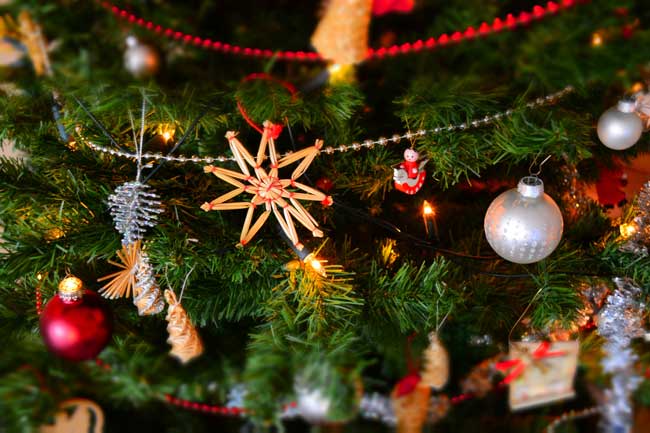 When the Ghost of Christmas Past bestows memories from my childhood, I see that my happiest Christmas memories aren’t opening presents. My happiest memories are decorating the Christmas tree. My mom and I would sing along to Christmas music, as she scuttled between the oven and the tree, to put in and take out Christmas cookies, as we decorated. Many of our ornaments were crafted by me: a hand-sewn felt angel, a beaded candy cane, a hand-painted glass ball. These memories make me smile.
When the Ghost of Christmas Past bestows memories from my childhood, I see that my happiest Christmas memories aren’t opening presents. My happiest memories are decorating the Christmas tree. My mom and I would sing along to Christmas music, as she scuttled between the oven and the tree, to put in and take out Christmas cookies, as we decorated. Many of our ornaments were crafted by me: a hand-sewn felt angel, a beaded candy cane, a hand-painted glass ball. These memories make me smile.
But did you know that until the 19th century, Americans considered the Christmas tree a strange custom? My research tells me it was. Clearly the idea eventually caught on, and here’s how it all started. (Maybe).
While the exact origin of the Christmas tree remains unclear, most historians agree the tradition began in the part of Northern Europe that is now Germany. Here, legend has it, in the early 1400s, people blended two customs that evolved into the Christmas tree as we know it.
On Christmas Eve, devout Catholics celebrated the feast day of Adam and Eve. This celebration featured “a tree of knowledge,” an evergreen fir with apples tied to its branches. Other “ornaments,” such as wool thread, straw, nuts and pretzels were added to the tree of knowledge.
The second custom, the Christmas Light, was a small triangular frame decorated with glass balls, tinsel, and a candle on top. The Christmas Light was a symbol of the “birth of Christ as the Light of World.” These Christmas Light decorations replaced the apples on the Tree of Knowledge. Adding the candle to the top of the new tree, Germans created what we now know as the Christmas tree.
For me, the lights on a Christmas tree are what I find so dazzling and spellbinding. Another legend credits the 16th century Protestant reformer, Martin Luther, with first adding lighted candles to tree branches. The story contends that Martin Luther was walking home one, winter evening, composing a sermon. He was inspired by the spectacular view of stars glowing through the branches of evergreen trees. Determined to share the beauty of this sight with his family, he erected a tree in his house and affixed its branches with lighted candles to mimic the twinkling stars.
When waves of German immigrants arrived in the U.S., one of the many traditions they brought from their home country was the Christmas tree. Early Pennsylvania German immigrants decorated their homes with Christmas trees in the 1700s and displayed community trees as early as 1747.
We see later examples in German immigrant communities in the Midwest and further west. Proving that Christmas ornaments could be anything easily acquired, German immigrants in Texas decorated trees with moss, cotton, pecans, popcorn, and red chili peppers!
The general public of 19th century Americans would finally embrace the Christmas tree only once it became “cool” to have a Christmas tree. Yes, the 19th century Americans were just as fashion-conscious as we are, and just as influenced by what the “cool kids” are doing. Before TikTok, before the internet, and before TV, women looked to magazines to discover the newest trend. Thus, it was an image of a Christmas tree in a women’s magazine that led to its popularity in the U.S.
During the mid-1800s, Queen Victoria of Great Britain was considered quite the trendsetter. Wearing a white dress on the day of her wedding to the German Prince Albert set the ideal for generations of later brides. If Queen Victoria was doing it, by golly, we ought to be doing it too!
Godey’s Lady’s Book was “the premier women’s magazine in America” in the mid-1800s. In 1848, the magazine reprinted an image of Queen Victoria, Prince Albert and their children standing around a Christmas tree, gazing at presents underneath. The Christmas tree immediately became fashionable.
The early 20th century saw Americans decorating their trees mainly with homemade ornaments, like the ones I crafted as a child. The 20th century also brought electricity to most homes, and the advent of Christmas lights, making it possible for Christmas trees to glow for days on end. With this, Christmas trees began to appear in town squares across the country, and having a Christmas tree in the home became an American tradition.
The Ghost of Christmas Present shows my daughter enjoying decorating our Christmas tree as much as I did. We’ve added a second generation of handmade ornaments, crafted by her, each holding its own special memory. The Ghost of Christmas Future reveals joyous visions of family Christmas trees for generations to come!
Amy McGarry, a Spokane Valley native, has been a regular Huckleberry Press contributor since 2018 and is the author of two memoirs: I am Farang: Adventures of a Peace Corps Volunteer in Thailand, and Culture Clash: My Marriage to a Moroccan Muslim.

